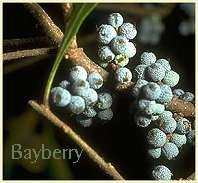
Iron Rushlights were common that also had a socket for a candle.



HOME | home
Iron on the Hearth | Iron, Cast and Forged | Cast Iron Cooking 4 | Copperware | Copper and Brassware 2 | Brass Alcohol Stove | Pipe Smoking | Tobacco the Indian Weed | Women's Pipes | Clay Pipe Collection | Pipes2 | pipes3 | Pipes4 | Pipe Tampers | Early Lighting 1 | Early Lighting 2 | Early Lighting 3 | Early Lighting 4 | Early Lighting 5 | Early Lighting 6 | My Lamps | Center Draft Lamps | Center Draft Lamps II | Center Drafts III | Miners lamps | Matches and Match Safes
Early Lighting 3
Candles to Illuminate
Some Background on Candles
from the National Candle Association
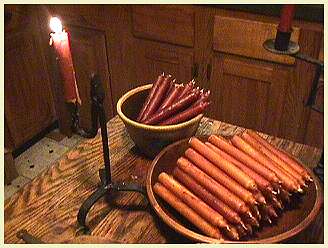
"For centuries, candles have cast a light on man's progress. However, there is very little known about the origin of candles. Although it is often written that the first candles were developed by the Ancient Egyptians who used rushlights, or torches, made by soaking the pithy core of reeds in molten tallow, the rushlights had no wick like a candle. It is the Romans who are credited with developing the wick candle, using it to aid travelers at dark, and lighting homes and places of worship at night.
Like the early Egyptians, the Romans relied on tallow, gathered from cattle or sheep suet, as the principal ingredient of candles. It was not until the Middle Ages when beeswax, a substance secreted by honey bees to make their honeycombs, was introduced. Beeswax candles were a marked improvement over those made with tallow, for they did not produce a smoky flame, or emit an acrid odor when burned. Instead, beeswax candles burned pure and clean. However, they were expensive, and, therefore, only the wealthy could afford them.
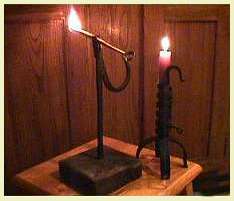
Iron Lighting Devices
Colonial women offered America's first contribution to candlemaking when they discovered that boiling the grayish green berries of bayberry bushes produced a sweet-smelling wax that burned clean. However, extracting the wax from the bayberries was extremely tedious. As a result, the popularity of bayberry candles soon diminished.
The growth of the whaling industry in the late 18th century brought the first major change in candlemaking since the Middle Ages, when spermaceti, a wax obtained by crystallizing sperm whale oil, became available in quantity. Like beeswax, the spermaceti wax did not elicit a repugnant odor when burned. Furthermore, spermaceti wax was found harder than both tallow and beeswax. It did not soften or bend in the summer heat. Historians note that the first "standard candles" were made from spermaceti wax.

Reproduction Tin candle sconce with reflector.
It was during the 19th century when most major developments affecting contemporary candlemaking occurred. In 1834, inventor Joseph Morgan introduced a machine which allowed continuous production of molded candles by the use of a cylinder which featured a movable piston that ejected candles as they solidified.
Further developments in candlemaking occurred in 1850 with the production of paraffin wax made from oil and coal shales. Processed by distilling the residues left after crude petroleum was refined, the bluish-white wax was found to burn cleanly, and with no unpleasant odor. Of greatest significance was its cost -- paraffin wax was more economical to produce than any preceding candle fuel developed. And while paraffin's low melting point may have posed a threat to its popularity, the discovery of stearic acid solved this problem. Hard and durable, stearic acid was being produced in quantity by the end of the 19th century. By this period, most candles being manufactured consisted of paraffin and stearic acid."
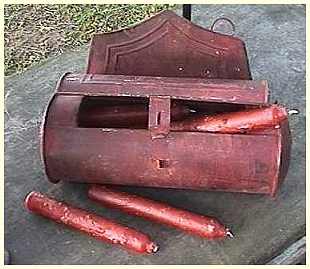
Reproduction candle safe
Candle boxes were placed conveniently in the house. They were both free standing and hung on the walls. They were made of wood, brass, sheet iron, and tin. Every home would have used some sort of a candle box in the home.
1030 15th Street, Suite 870
Washington, DC 20005
202-393-2210
Beeswax Candles
By Beth Maxwell Boyle
Most people agree, beeswax makes the finest candles ever known. Properly made beeswax candles produce a bright flame, do not drip, do not smoke and do not sputter. They also emit a fragrant odor while being burned. Ancient peoples thought bees gathered beeswax from plants. The Greek philosopher, Aristotle believed this to be fact. He most likely mistook pollen for beeswax, or he confused it with propolis. Propolis is a resinous pitch that the bees do actually gather from plants.
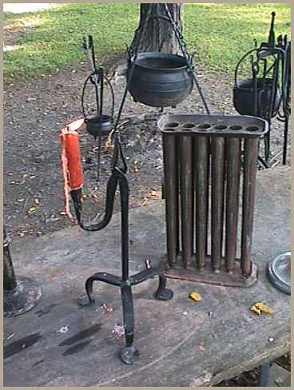
Antique tin candlemold to make twelve tapers at a time
and a repro. combination rush light /candle holder of iron.
Beeswax uses have been recorded in all of mankind's history. It was widely used by the ancient Egyptians. Today it is still used because beeswax candles burn significantly longer than petroleum based, paraffin candles. They also have the highest melting point of any known candle wax. Beeswax tapers burn virtually dripless if they are not burned in an area with a draft. Beeswax candles are pure and clean burning candles without smoke which makes them ideal for illumination indoors and they have always been prized for this above all else. Beeswax provides a brighter flame than paraffin and produces a sweet smell of honey that is simply wonderful. Strangely enough, some studies have shown that the burning of beeswax stimulates the pituitary gland.
The spectrum of light emitted when burning a beeswax candle is the same as natural sunlight. Paraffin candles produce a flame in the chaotic light spectrum much like an incandescent light bulb. The Bible refers frequently to beeswax. As far back as Roman times, beeswax was a major product in Europe, and taxes or tribute were commonly extracted in the form of beeswax. Old records of massive quantities of wax being produced indicate a significantly higher level of beekeeping than is currently employed today!
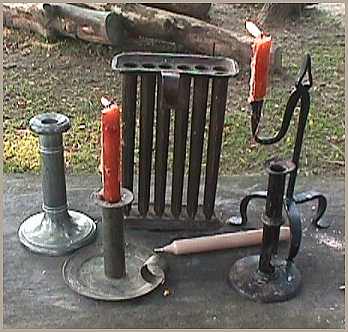
Pewter, Tin, and Iron candleholders and tin candlemold.
When beeswax candles came into wide use, the symbolism of candles and flames emerged to coincide with Church beliefs. Although originally beeswax was used only in theChurch and wealthy homes its qualities were well known. Because beeswax was so special in peoples minds, beeswax candles could be used symbolically in the early Church. It was taught that beeswax symbolized the Virgin Mother, the wick symbolized the soul of Jesus Christ, and the flame, the divinity, that surrounds and illuminates the two. During burning, beeswax can visually expend themselves as Christ expended Himself in His love for mankind. Even today votive candles represent ongoing prayer for a special intention. Also,the bee became a symbol of the resurrection and of the immortality of the soul. Interestingly, by the Twelfth century candles had become the norm in churches, rather than oil lamps. Few people know the word ceremony comes from the Latin word cermonius, meaning "the person who carries a wax candle at public rituals". Even today the Greek Orthodox Church is known widely for the production and use of very fine beeswax candles. Beeswax is sometimes added to modern petroleum based candles to raise the temperature they burn and prevent dripping.
In early America beeswax was a product that could be made on the farm but was too valuable a product to be sold for most households to expend their supplies on everyday use. Certainly it was in wide use in churches and in the wealthy homes of Boston and Virginia as it was a sought after luxury item. Beeswax had many uses in early America besides candlemaking including wood finishing and as a lubricant for machinery.

A simple, forged iron candelabra with three candle sockets
that can be hung from the ceiling or even in a tent. This is more than likely a replica.

BAYBERRY CANDLES
BAYBERRY-TALLOW, or MYRTLE WAX (Bayberry wax.)—This substance is yielded by the berries and is obtained by boiling them in water, upon the top of which it floats, and from which it is removed when it has become cold and hardened; it is a concrete oil or fatty substance of a pale-green color, with a tendency to dirty gray, of moderate hardness and consistence, having the tenacity of beeswax, but more brittle and not so unctuous to the touch, of a faintly balsamic and pleasant odor which is increased by burning it, and of an astringent, bitterish taste. It fuses at a temperature of from 47° to 49° C. (116.6° to 120.2° F.) (Moore), burns with a clear, white flame, producing little smoke, and has the specific gravity 1.004 to 1.006. Water does not act upon it; boiling alcohol dissolves about four-fifths of its weight, but deposits it again upon cooling; but ether also dissolves it, and on cooling deposits it in crystalline plates like spermaceti; the ether becomes green, leaving the wax nearly white; oil of turpentine, aided by heat, dissolves it sparingly; alkalies and acids act upon it nearly as upon beeswax. Sulphuric acid, assisted by heat, dissolves about one-twelfth of its weight, and converts it into a thick, dark-brown mass. A bushel of bayberries will yield about 4 pounds of the wax.
Are made from this shrub.

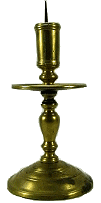
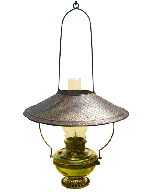
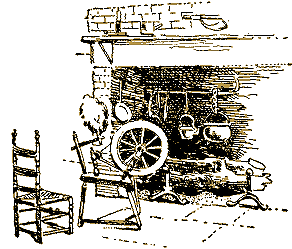
No part of this website may be used for any purpose ( including using images )
without written consent from The Rams Horn
